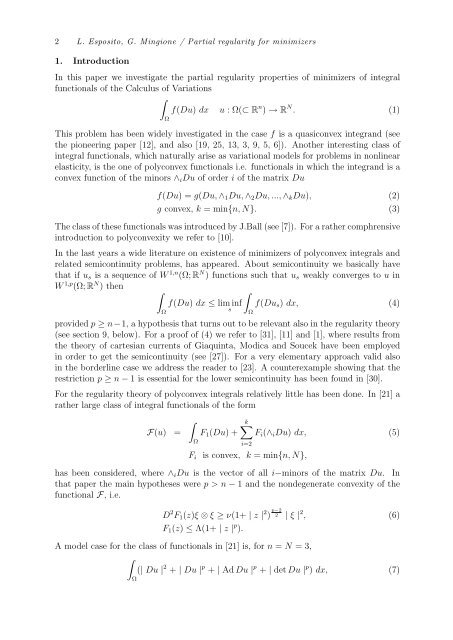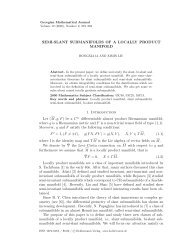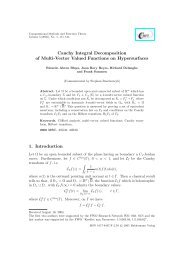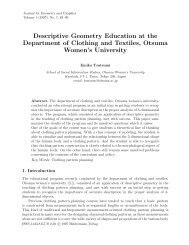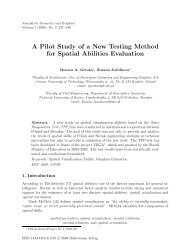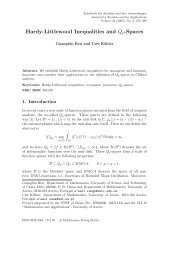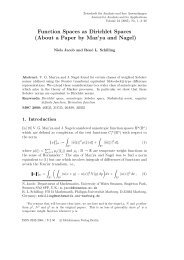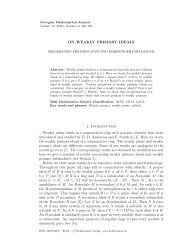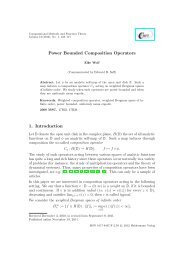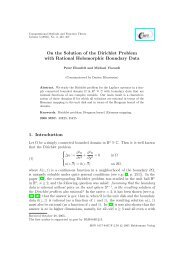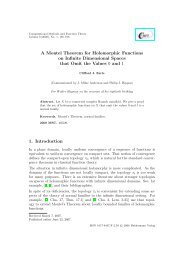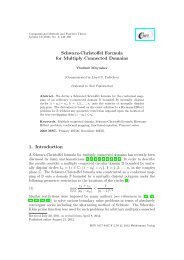Partial Regularity for Minimizers of Degenerate Polyconvex Energies
Partial Regularity for Minimizers of Degenerate Polyconvex Energies
Partial Regularity for Minimizers of Degenerate Polyconvex Energies
You also want an ePaper? Increase the reach of your titles
YUMPU automatically turns print PDFs into web optimized ePapers that Google loves.
2 L. Esposito, G. Mingione / <strong>Partial</strong> regularity <strong>for</strong> minimizers<br />
1. Introduction<br />
In this paper we investigate the partial regularity properties <strong>of</strong> minimizers <strong>of</strong> integral<br />
functionals <strong>of</strong> the Calculus <strong>of</strong> Variations<br />
∫<br />
f(Du) dx u : Ω(⊂ R n ) → R N . (1)<br />
Ω<br />
This problem has been widely investigated in the case f is a quasiconvex integrand (see<br />
the pioneering paper [12], and also [19, 25, 13, 3, 9, 5, 6]). Another interesting class <strong>of</strong><br />
integral functionals, which naturally arise as variational models <strong>for</strong> problems in nonlinear<br />
elasticity, is the one <strong>of</strong> polyconvex functionals i.e. functionals in which the integrand is a<br />
convex function <strong>of</strong> the minors ∧ i Du <strong>of</strong> order i <strong>of</strong> the matrix Du<br />
f(Du) = g(Du, ∧ 1 Du, ∧ 2 Du, ..., ∧ k Du), (2)<br />
g convex, k = min{n, N}. (3)<br />
The class <strong>of</strong> these functionals was introduced by J.Ball (see [7]). For a rather comphrensive<br />
introduction to polyconvexity we refer to [10].<br />
In the last years a wide literature on existence <strong>of</strong> minimizers <strong>of</strong> polyconvex integrals and<br />
related semicontinuity problems, has appeared. About semicontinuity we basically have<br />
that if u s is a sequence <strong>of</strong> W 1,n (Ω; R N ) functions such that u s weakly converges to u in<br />
W 1,p (Ω; R N ) then<br />
∫<br />
∫<br />
f(Du) dx ≤ lim inf f(Du s ) dx, (4)<br />
Ω<br />
s<br />
Ω<br />
provided p ≥ n−1, a hypothesis that turns out to be relevant also in the regularity theory<br />
(see section 9, below). For a pro<strong>of</strong> <strong>of</strong> (4) we refer to [31], [11] and [1], where results from<br />
the theory <strong>of</strong> cartesian currents <strong>of</strong> Giaquinta, Modica and Soucek have been employed<br />
in order to get the semicontinuity (see [27]). For a very elementary approach valid also<br />
in the borderline case we address the reader to [23]. A counterexample showing that the<br />
restriction p ≥ n − 1 is essential <strong>for</strong> the lower semicontinuity has been found in [30].<br />
For the regularity theory <strong>of</strong> polyconvex integrals relatively little has been done. In [21] a<br />
rather large class <strong>of</strong> integral functionals <strong>of</strong> the <strong>for</strong>m<br />
F(u) =<br />
∫<br />
Ω<br />
F i<br />
F 1 (Du) +<br />
k∑<br />
F i (∧ i Du) dx, (5)<br />
i=2<br />
is convex, k = min{n, N},<br />
has been considered, where ∧ i Du is the vector <strong>of</strong> all i−minors <strong>of</strong> the matrix Du. In<br />
that paper the main hypotheses were p > n − 1 and the nondegenerate convexity <strong>of</strong> the<br />
functional F, i.e.<br />
D 2 F 1 (z)ξ ⊗ ξ ≥ ν(1+ | z | 2 ) p−2<br />
2 | ξ | 2 , (6)<br />
F 1 (z) ≤ Λ(1+ | z | p ).<br />
A model case <strong>for</strong> the class <strong>of</strong> functionals in [21] is, <strong>for</strong> n = N = 3,<br />
∫<br />
(| Du | 2 + | Du | p + | Ad Du | p + | det Du | p ) dx, (7)<br />
Ω


